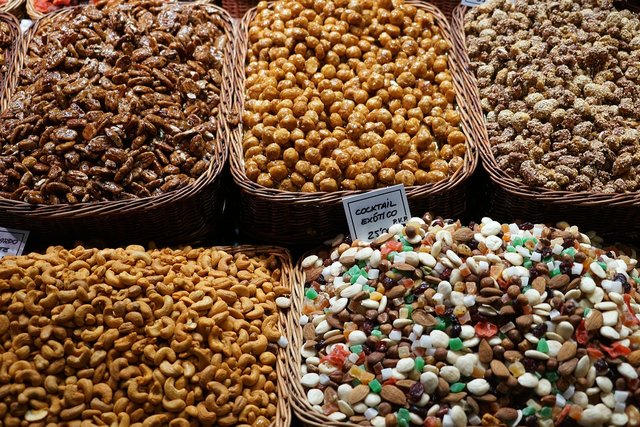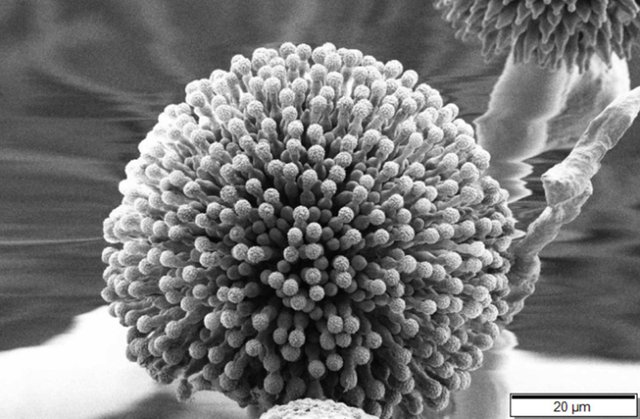Tox-blog #4: Aflatoxins in food – The world’s most potent natural cancer promotors
These potent toxins originate from a mold species growing on nuts and are a major threat to human health.
 Delicious, right? Eating the wrong ones can literally kill you without you taking notice. Source
Delicious, right? Eating the wrong ones can literally kill you without you taking notice. Source
Intro
Today, it should be common knowledge that moldy food is unhealthy because of the chemical compounds produced by those fungi – the so-called “mycotoxins”. But when it comes to toxicity, one subgroup of those beats all the others by lengths: the aflatoxins.
Aflatoxins are produced by some species of Aspergillus molds, which grow predominantly on grains or nuts in in regions with hot climate, but thanks to globalized agriculture, they have become a relevant health issue for inhabitants of temperate zones as well.
Their main representative, aflatoxin B1 (AFB1), is extremely genotoxic (=it damages the DNA) and gained fame as the strongest natural carcinogen (=cancer-promoting/causing compound).
Reason enough to write another tox-blog. Let’s come together and take a look on where to find those toxins and what they might be doing to you.
Where to find aflatoxins
Aspergillus flavus, the most important aflatoxin-producing organism, lives in the soil in tropical and sub-tropical climate zones. As all molds, it needs a certain humidity to grow. Thus, it mainly gets into the food chain if agricultural products haven’t been stored properly – in particular not dry enough. Then, Aspergillus flavus is able to contaminate grains and nuts.
The former has high relevance for sub-Saharan African countries, where in some areas farming conditions are very bad. Often, barns for storing crops are not well enough protected against moisture, which leads to high concentrations of mycotoxins in local cereals. Especially children have been found to be at high risk, with some local studies (in particular from Nigeria) even suggesting a connection of aflatoxin intake with the higher prevalence of stunted growth in those countries.
The contamination of nuts is more of relevance to Western countries, as they are the prime importers of those agricultural products, with an increasing demand for exotic (non-native) nuts.
 A beautiful Aspergillus "flower" under the microscope. Source
A beautiful Aspergillus "flower" under the microscope. Source
Aflatoxin Toxicity
As written in the intro, AFB1 is extremely genotoxic. But how does it work?
To answer that question, let’s look back at the article I wrote a few days ago about the xenobiotic metabolism, our intrinsic defense system against many poisons. Somewhere near the end, I told you that occasionally the system backfires and creates a toxin out of a less toxic compound. This is exactly what happens when you take up AFB1.
It is metabolized by a phase I enzyme called CYP3A4, which adds a very reactive functional group (for chemists: it’s an epoxy-group!) to the molecule. With this group, the formed metabolite is able to bind to guanine, one of the building blocks of our DNA, resulting in a so-called “bulky DNA adduct”.
To visualize it, imagine a brick solidly attached to a gear-wheel that is supposed to work in a complicated machine, just 100,000-times smaller. Of course, the machine will malfunction: nuclear enzymes are not able to read the DNA correctly any more at positions where those adducts occur, which leads to errors with translating the gene code to proteins or even with copying the DNA – so-called “mutations”. Mutations in genes that are involved in cell growth or the programmed death of non-functional cells ultimately lead to the development of cancer.
By this mechanism, AFB1 is acutely toxic to both liver and kidneys (the two prime organs for the metabolism), but is also extremely mutagenic and carcinogenic, as demonstrated in several studies. It exerts its toxic effects at very low concentrations (below 10 µg/kg bodyweight), that can be reached by eating just one (!) contaminated nut.
Why monitoring aflatoxins is so difficult & concluding remarks
And that is the main problem here: monitoring every single nut during food quality control is impossible. All you can do is analyze samples. A few nuts here and there, and the occasional processed food. But as the majority of nuts is not contaminated, and one contaminated nut is all you need to ruin the safety of your food, it’s like looking for the famous needle in a haystack.
All we can try to do is prevention, prevention, prevention. To educate farmers – especially in underdeveloped regions - to store their products dry, and to educate consumers to be careful (job right now^^):
If one of your delicious para nuts or cashews doesn’t look right, don’t eat it! If it tastes wrong, spit it out! Liver cancer is one of the last things you would like to experience.
Additional sources:
Article
Review
Review
Book "Toxikologie für Naturwissenschaftler und Mediziner." Eisenbrandt, Metzler, Menneke. Wiley-VCH
Lectures "Toxicology" and "Food Toxicology" by Prof. Marko, University of Vienna
Disclaimer: In my blog, I'm stating my honest opinion as a researcher, not less and not more. Sometimes I make errors. Discuss and disagree with me - if you are bringing the better arguments, I might rethink.
Was soll ich sagen, wieder mal: "Shut up and take my upvote!" ;)
stets zu Diensten und danke ;-)
Ebenfalls stets gerne zu Diensten, v.a. weil ich dich auch hin und wieder bei Neuankömmlingen von @welcoming sehe, vote ich hier wirklich sehr gerne!
ich habe leider nicht die Zeit da so aktiv zu sein wie du, aber ich versuch halt immer wieder mal reinzuschauen, v. a. wenn ich Jungwissenschaftler entdecke ;-)
Mir hat es auch extrem geholfen, irgendwo in einem Kommentar auf steemstem hingewiesen zu werden, also geb ich ihnen das auch immer mit auf den weg.
Great article about mycotoxins. Having worked with Aspergillus and his friends for a couple of years, I know how hard it is to raise awareness. You don't feel the toxin immediately, that's why many people still don't take mycotoxins seriously. Took me years to convince my family that cutting off the mouldy bit is not enough. So everyone who's read this post: Be wise, throw away mouldy food and try to stay away from certain fungi. They are pretty under the microscope but they have the license to kill (slowly).
Good and informative post, Thanks for sharing @sco
Thanks, it's very nice for you to say so, and I gave you a little upvote for this politeness. But then I realized you didn't upvote my post, so I had to remove the vote again. Sorry.
I did it, But my voting power is not enough, I'm account is empty so that's why I didn't :(
ah, now you did. There we go, and thanks^^
Thank You :) @sco
Holy crap...good to know! Love this post, keep it up! https://steemit.com/@muscleroast.com
@OriginalWorks
The @OriginalWorks bot has determined this post by @sco to be original material and upvoted it!
To call @OriginalWorks, simply reply to any post with @originalworks or !originalworks in your message!
This post has received a 0.05 % upvote from @drotto thanks to: @steemstem-bot.
Well done! This post has received a 33.33 % upvote from @litasio thanks to: @steemstem-bot. Whoop!
If you would like to delegate to the @LitasIO you can do so by clicking on the following link: Delegate 10SP
Congratulations @sco, this post is the fifth most rewarded post (based on pending payouts) in the last 12 hours written by a User account holder (accounts that hold between 0.1 and 1.0 Mega Vests). The total number of posts by User account holders during this period was 3971 and the total pending payments to posts in this category was $9168.63. To see the full list of highest paid posts across all accounts categories, click here.
If you do not wish to receive these messages in future, please reply stop to this comment.